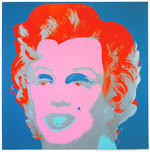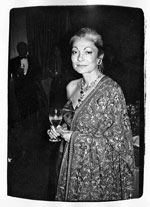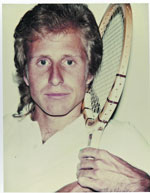 | | | Marilyn Monroe, 1962 screenprint 36 x 36"
Collection of the San Francisco Museum of Modern Art Gift of the
estate of Wilfred Cohen
CThe Andy Warhol Foundation for the Visual Arts/ARS, New York
| | | | | | Andy Warhol lied. Since his death in 1987, and even before, he has clearly had more than 15 minutes of fame. And with the new exhibit at Saint Mary's College's (SMC) Hearst Gallery, running April 11 through June 20, he's adding to his numbers.
 Luckily, Warhol deserves the time. Better known than Matisse, the master colorist to whom he has been compared, Warhol will forever be a major force in the world of art. A lesser artist, equally enraptured by celebrities and material goods, might have been dismissed as a pop culture phenomenon. But even a cursory study-and the Hearst Gallery exhibit allows far more than that-reveals the sly genius behind the work.
Luckily, Warhol deserves the time. Better known than Matisse, the master colorist to whom he has been compared, Warhol will forever be a major force in the world of art. A lesser artist, equally enraptured by celebrities and material goods, might have been dismissed as a pop culture phenomenon. But even a cursory study-and the Hearst Gallery exhibit allows far more than that-reveals the sly genius behind the work.
 In honor of the Andy Warhol Foundation's 20th anniversary, colleges and university art museums across the United States were given photographs from the collection. The Hearst Gallery received 152 photographs, including celebrities, sports figures, runway shots, New York City streets and bridges, and others. Wesley Gibson, author and professor in English and graduate Creative Writing at SMC, is the guest curator and essay writer for the exhibit. "The foundation wanted the photos to be preserved," he explains, providing background for the spectacular donation. "We've framed them and they are even more beautiful than when we first looked at them."
In honor of the Andy Warhol Foundation's 20th anniversary, colleges and university art museums across the United States were given photographs from the collection. The Hearst Gallery received 152 photographs, including celebrities, sports figures, runway shots, New York City streets and bridges, and others. Wesley Gibson, author and professor in English and graduate Creative Writing at SMC, is the guest curator and essay writer for the exhibit. "The foundation wanted the photos to be preserved," he explains, providing background for the spectacular donation. "We've framed them and they are even more beautiful than when we first looked at them."
 Included in the collection are photos from private and public collections that demonstrate Warhol's fascination with life's commonplace elements and its decadence. There is the notorious Campbell soup can, and celebrities, like Dolly Parton or Yves Saint Laurent, and there is technology, with Polaroid camera and photo booth prints. Reminiscent of Warhol's famous time capsules-the 612 cardboard boxes he filled with daily mail, gifts, and items falling into the category of "stuff,"-the photos capture both the man and the era.
Included in the collection are photos from private and public collections that demonstrate Warhol's fascination with life's commonplace elements and its decadence. There is the notorious Campbell soup can, and celebrities, like Dolly Parton or Yves Saint Laurent, and there is technology, with Polaroid camera and photo booth prints. Reminiscent of Warhol's famous time capsules-the 612 cardboard boxes he filled with daily mail, gifts, and items falling into the category of "stuff,"-the photos capture both the man and the era.
 "I think he was a visionary in the way his cultural antennae was up," says Gibson. Warhol appreciated American impatience and capitalized on the trend, holding up a mirror to our fondness for speed and instant reward with his Polaroid series. It's worthwhile to consider: what would Warhol think about YouTube and reality TV? "With his embrace of the material, of technology, I think he'd be thrilled with YouTube," Gibson answers.
"I think he was a visionary in the way his cultural antennae was up," says Gibson. Warhol appreciated American impatience and capitalized on the trend, holding up a mirror to our fondness for speed and instant reward with his Polaroid series. It's worthwhile to consider: what would Warhol think about YouTube and reality TV? "With his embrace of the material, of technology, I think he'd be thrilled with YouTube," Gibson answers.
 In a press release, Hearst director Carrie Brewster echoes Gibson's words: "Warhol was a complicated figure and an enigma. We think we know him, but he continually surprises us." Gibson encourages visitors to consider how the artist used photography, noting Warhol's progression from found images to made imagery. Keeping with the Warhol philosophy of art in the every day, Flipvideo 'screen test' portraits will allow anyone to have fifteen minutes of fame-or more-at the exhibition.
In a press release, Hearst director Carrie Brewster echoes Gibson's words: "Warhol was a complicated figure and an enigma. We think we know him, but he continually surprises us." Gibson encourages visitors to consider how the artist used photography, noting Warhol's progression from found images to made imagery. Keeping with the Warhol philosophy of art in the every day, Flipvideo 'screen test' portraits will allow anyone to have fifteen minutes of fame-or more-at the exhibition.
 Lecture: Tonight, Wednesday, April 14, 7 PM, Soda Center
Lecture: Tonight, Wednesday, April 14, 7 PM, Soda Center
 Warhol the Filmmaker, by David E. James, PhD, is a professor at the School of Cinematic Arts at the University of Southern California, Academy Film Scholar, Getty Fellow, and author of numerous books on Hollywood and avant-garde film and music. Free.
Warhol the Filmmaker, by David E. James, PhD, is a professor at the School of Cinematic Arts at the University of Southern California, Academy Film Scholar, Getty Fellow, and author of numerous books on Hollywood and avant-garde film and music. Free.
 Sponsored by the Disney Forum.
Sponsored by the Disney Forum.

|


